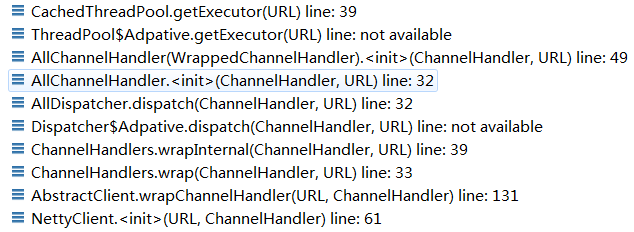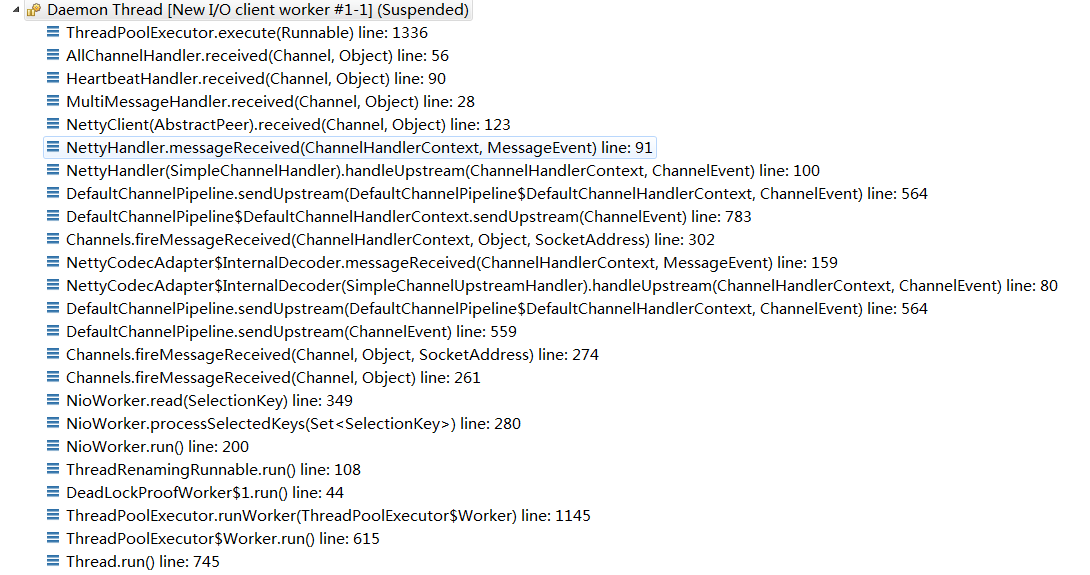1. 创建线程池
创建线程池的调用栈如下:

SimpleDataStore把线程池存放在map中。
public class NettyClient extends AbstractClient { public NettyClient(final URL url, final ChannelHandler handler) throws RemotingException{ //首先调用父类的wrapChannelHandler方法,创建DubboClientHandler线程池 super(url, wrapChannelHandler(url, handler)); } } public abstract class AbstractClient extends AbstractEndpoint implements Client { protected static final String CLIENT_THREAD_POOL_NAME = "DubboClientHandler"; //DubboClientHandler线程池 protected volatile ExecutorService executor; public AbstractClient(URL url, ChannelHandler handler) throws RemotingException { //省略其他非相关代码 //从SimpleDataStore中获取线程池 executor = (ExecutorService) ExtensionLoader.getExtensionLoader(DataStore.class) .getDefaultExtension().get(Constants.CONSUMER_SIDE, Integer.toString(url.getPort())); ExtensionLoader.getExtensionLoader(DataStore.class) .getDefaultExtension().remove(Constants.CONSUMER_SIDE, Integer.toString(url.getPort())); } protected static ChannelHandler wrapChannelHandler(URL url, ChannelHandler handler){ //给线程命名 url = ExecutorUtil.setThreadName(url, CLIENT_THREAD_POOL_NAME); url = url.addParameterIfAbsent(Constants.THREADPOOL_KEY, Constants.DEFAULT_CLIENT_THREADPOOL); return ChannelHandlers.wrap(handler, url); } } public class WrappedChannelHandler implements ChannelHandlerDelegate { protected final ExecutorService executor; public WrappedChannelHandler(ChannelHandler handler, URL url) { this.handler = handler; this.url = url; //此处创建了线程池 executor = (ExecutorService) ExtensionLoader.getExtensionLoader(ThreadPool.class)
.getAdaptiveExtension().getExecutor(url); String componentKey = Constants.EXECUTOR_SERVICE_COMPONENT_KEY; if (Constants.CONSUMER_SIDE.equalsIgnoreCase(url.getParameter(Constants.SIDE_KEY))) { componentKey = Constants.CONSUMER_SIDE; } DataStore dataStore = ExtensionLoader.getExtensionLoader(DataStore.class).getDefaultExtension(); dataStore.put(componentKey, Integer.toString(url.getPort()), executor); } }
executor = (ExecutorService) ExtensionLoader.getExtensionLoader(ThreadPool.class).getAdaptiveExtension().getExecutor(url);
ThreadPool$Adpative代码如下:
package com.alibaba.dubbo.common.threadpool; import com.alibaba.dubbo.common.extension.ExtensionLoader; public class ThreadPool$Adpative implements com.alibaba.dubbo.common.threadpool.ThreadPool { public java.util.concurrent.Executor getExecutor( com.alibaba.dubbo.common.URL arg0) { if (arg0 == null) throw new IllegalArgumentException("url == null"); com.alibaba.dubbo.common.URL url = arg0; // url中的默认参数threadpool=cached String extName = url.getParameter("threadpool", "fixed"); if (extName == null) throw new IllegalStateException( "Fail to get extension(com.alibaba.dubbo.common.threadpool.ThreadPool) name from url(" + url.toString() + ") use keys([threadpool])"); com.alibaba.dubbo.common.threadpool.ThreadPool extension = (com.alibaba.dubbo.common.threadpool.ThreadPool) ExtensionLoader .getExtensionLoader(com.alibaba.dubbo.common.threadpool.ThreadPool.class) .getExtension(extName); return extension.getExecutor(arg0); } }
CachedThreadPool类:
/**
* 此线程池可伸缩,线程空闲一分钟后回收,新请求重新创建线程
*
*/
public class CachedThreadPool implements ThreadPool {
public Executor getExecutor(URL url) {
String name = url.getParameter(Constants.THREAD_NAME_KEY, Constants.DEFAULT_THREAD_NAME);
int cores = url.getParameter(Constants.CORE_THREADS_KEY, Constants.DEFAULT_CORE_THREADS);
int threads = url.getParameter(Constants.THREADS_KEY, Integer.MAX_VALUE);
int queues = url.getParameter(Constants.QUEUES_KEY, Constants.DEFAULT_QUEUES);
int alive = url.getParameter(Constants.ALIVE_KEY, Constants.DEFAULT_ALIVE);
return new ThreadPoolExecutor(cores, threads, alive, TimeUnit.MILLISECONDS,
queues == 0 ? new SynchronousQueue<Runnable>() :
(queues < 0 ? new LinkedBlockingQueue<Runnable>()
: new LinkedBlockingQueue<Runnable>(queues)),
new NamedThreadFactory(name, true), new AbortPolicyWithReport(name, url));
}
}
2. 往线程池投送任务
线程池创建之后,是谁在什么时候往里面扔任务呢?

public class AllChannelHandler extends WrappedChannelHandler { public void received(Channel channel, Object message) throws RemotingException { ExecutorService cexecutor = getExecutorService(); try { //往线程池扔任务 cexecutor.execute(new ChannelEventRunnable(channel, handler, ChannelState.RECEIVED, message)); } catch (Throwable t) { throw new ExecutionException(message, channel, getClass() + " error when process received event .", t); } } private ExecutorService getExecutorService() { //executor在父类WrappedChannelHandler中 ExecutorService cexecutor = executor; if (cexecutor == null || cexecutor.isShutdown()) { cexecutor = SHARED_EXECUTOR; } return cexecutor; } }
也就是说nio线程往DubboClientHandler线程池扔任务,DubboClientHandler线程再唤醒等待的consumer调用线程。
3. 线程池执行任务


